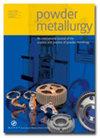添加B对元素粉末热挤压制备Cu-B复合材料微观结构和导热性能的影响
IF 1.8
4区 材料科学
Q2 METALLURGY & METALLURGICAL ENGINEERING
引用次数: 0
摘要
本文章由计算机程序翻译,如有差异,请以英文原文为准。
Effects of B addition on microstructure and thermal conductivity of Cu–B composites produced by hot-extrusion of elemental powders
ABSTRACT This work proposes a new neutron absorber, Cu–B composites, with excellent thermal conductivity and good neutron absorbing capability. Mixtures of elemental Cu and B powders with the B contents varying between 10 and 40 at.-% were consolidated into round bars by hot extrusion. The addition of B significantly refined the grain structure, which is related to the suppression of dynamic recrystallisation during hot extrusion and extended recovery during subsequent annealing. Such fine-grained structure in Cu–B composites together with dispersion hardening by B particles contributed to the higher hardness of Cu–B composites. The thermal conductivity of Cu–B composites, being roughly two times higher than that of Al–B4C MMC, decreases with increasing the B contents, which is mainly due to higher volume fraction B particles with lower thermal conductivity, and partly to texture randomisation and refined grain structure in the Cu–B composites.
求助全文
通过发布文献求助,成功后即可免费获取论文全文。
去求助
来源期刊

Powder Metallurgy
工程技术-冶金工程
CiteScore
2.90
自引率
7.10%
发文量
30
审稿时长
3 months
期刊介绍:
Powder Metallurgy is an international journal publishing peer-reviewed original research on the science and practice of powder metallurgy and particulate technology. Coverage includes metallic particulate materials, PM tool materials, hard materials, composites, and novel powder based materials.
 求助内容:
求助内容: 应助结果提醒方式:
应助结果提醒方式:


